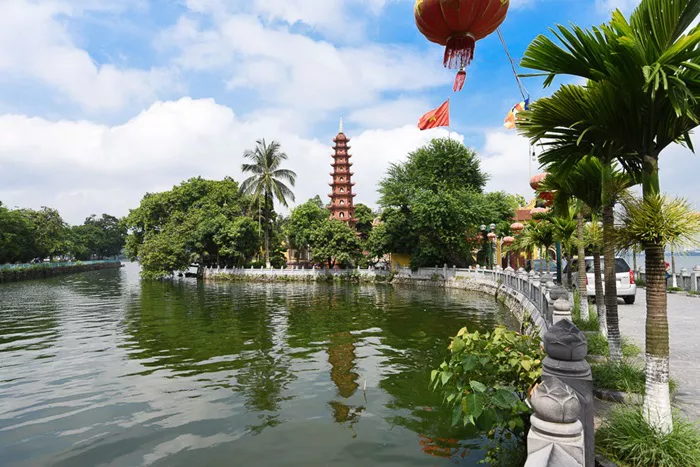Tran Quoc Temple is one of the oldest and most famous Buddhist temples in Vietnam. Located on a small island in the West Lake of Hanoi, this temple has a long history and holds great religious significance for Vietnamese Buddhists. It is also a beautiful place that attracts many visitors who want to learn about Buddhist culture and enjoy peaceful scenery.
Development History of Tran Quoc Temple
Founding and Early History
Tran Quoc Temple was first built in the 6th century during the reign of Emperor Ly Nam De. At that time, it was named Khai Quoc Temple, which means “Nation Opening Temple.” The temple was built to pray for peace and prosperity for the country. Over the centuries, it has been repaired and expanded several times, adapting to the changes in architecture and religious needs.
Renaming and Restoration
In the 17th century, the temple was renamed Tran Quoc, which means “Protecting the Nation.” This name reflects the temple’s role as a spiritual protector of the Vietnamese people. Many restorations happened during the Tran and later dynasties to preserve the temple’s structures and enhance its beauty.
Modern Era
Today, Tran Quoc Temple has become not only a place of worship but also a cultural symbol of Hanoi. The temple underwent significant restoration in the 20th century to maintain its architecture and accommodate growing numbers of visitors and Buddhists. It is now considered a must-visit destination for anyone interested in buddhist temples and spiritual practice.
Religious Influence of Tran Quoc Temple
A Center of Buddhist Practice
Tran Quoc Temple has been an important center for Buddhist practice in Vietnam for over 1,400 years. It serves as a place for monks and laypeople to gather for meditation, chanting, and studying Buddhist teachings. The temple promotes the core values of Buddhism such as compassion, mindfulness, and non-attachment.
Spiritual Role in Vietnamese Society
For many Vietnamese, Tran Quoc Temple is more than a historic site. It is a spiritual refuge where people come to seek peace, blessings, and guidance in their daily lives. During important Buddhist festivals like Vesak and Vu Lan, the temple becomes a vibrant place filled with ceremonies and prayers that unite the community.
Promotion of Buddhist Education
The temple also plays a role in Buddhist education. It hosts lectures and classes to help people better understand Buddhist philosophy and ethics. This educational role helps keep Buddhism alive and relevant in modern Vietnamese society.
Overview of Scenic Spots at Tran Quoc Temple
Temple Architecture and Layout
Tran Quoc Temple is a fine example of temple architecture that blends harmoniously with nature. The temple complex consists of several main buildings, including the main hall, bell tower, and pagoda. Each structure is decorated with intricate carvings and statues that tell stories from Buddhist teachings.
The Main Hall
The main hall is the heart of the temple where the large statue of the Buddha sits. The hall is a peaceful place where visitors and monks come to pray and meditate. The architecture is simple yet elegant, reflecting the Buddhist values of modesty and serenity.
The Bell Tower
The bell tower holds an ancient bronze bell that is rung during ceremonies. The sound of the bell is believed to spread peace and good fortune to the surrounding community. It is also a symbol of mindfulness, reminding people to be aware of each moment.
The 15-Story Pagoda
One of the most famous features of Tran Quoc Temple is its tall pagoda. The 15-story tower stands proudly near the lake, visible from many parts of Hanoi. This pagoda is a symbol of the temple’s long history and its spiritual strength. Visitors often climb the pagoda to enjoy a panoramic view of the West Lake and the city.
Natural Beauty Surrounding the Temple
Tran Quoc Temple is surrounded by the tranquil waters of West Lake and lush greenery. The peaceful environment creates a perfect setting for meditation and reflection. Visitors can walk along the lakeside paths, enjoy the fresh air, and admire the lotus ponds that bloom beautifully in the summer.
Cultural and Spiritual Activities
The temple hosts many cultural and spiritual activities throughout the year. These include Buddhist festivals, meditation retreats, and traditional ceremonies. These events offer visitors a chance to experience Vietnamese Buddhist culture firsthand and connect with the spiritual energy of the place.
Conclusion
Tran Quoc Temple is a treasure of Vietnam’s Buddhist heritage. Its long development history, deep religious influence, and stunning scenic spots make it a unique and meaningful place. Whether you come to pray, learn about Buddhism, or simply enjoy the peaceful atmosphere, Tran Quoc Temple offers a rich experience that touches both heart and mind.

